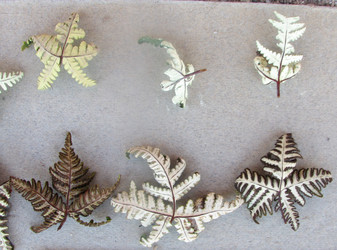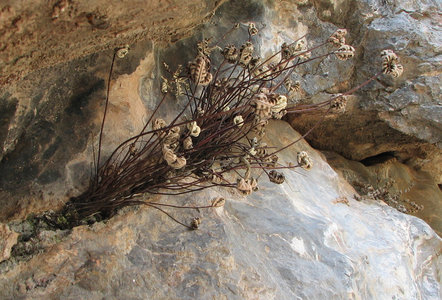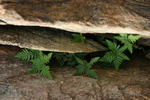Notholaena standleyi
Northern Desert Star Cloakfern
Carl RothfelsIntroduction
Notholaena standleyi is one of the most striking ferns of Mexico and the southwestern US (Arizona, Colorado, New Mexico, Oklahoma, Texas). It is locally common in rock cracks and sheltered pockets under boulders in dry exposed sites. Along with Astrolepis spp., N. standleyi is perhaps the most xeric-tolerant of all ferns. The farina composition (and color) varies considerably within this species. Seigler and Wollenweber (1983) distinguished three “chemotypes”—groups within N. standleyi that differ in farina composition, geographic range, and substrate preferences—and Windham and Yatskievych (unpublished data) distinguished a fourth. These four chemotypes (informally referred to as Gold, Pallid, Yellow, and Yellow-Green) also differ in their ploidy levels (number of complete chromosome sets they contain). Gold and Yellow are diploids, while Pallid and Yellow-Green are tetraploids (Windham and Yatskievych, unpublished data). Preliminary data (Rothfels et al., 2008) suggest that these four chemotypes may be phylogenetic units worthy of taxonomic recognition, but more study is needed.


Farina composition and color vary considerably within Notholaena standleyi. The leaves in this photograph probably represent the Gold chemotype (left) and Yellow chemotype (center and right). They are from one of very few known mixed chemotype populations. © 2008 Carl Rothfels
Characteristics
The thick, star-shaped leaves of these species are distinctive; they could be confused with only the very similar N. sulphurea (the blade of N. standleyi is pinnatifid—all the lobes are connected by a strip of green leaf tissue—whereas in N. sulphurea the terminal lobe is on its own short stalk, separate from the side lobes). The blades are elevated on wiry stalks and densely covered with farina beneath—white to cream to light yellow in the Pallid and Yellow chemotypes; deep gold, greenish yellow, to brown in the Gold and Yellow-Green chemotypes. When the plants are water stressed (which is much of the time in their typical habitats), the leaves curl into tight balls, exposing their farina-covered undersides.


Yellow chemomorph of Notholaena standleyi with the leaves curled exposing their farina-covered undersides. © 2008 Carl Rothfels
Other Names for Notholaena standleyi
- Notholaena candida var. quinquefidopalmata
- Notholaena hookeri
- Notholaena sulphurea var. quinquifidopalmata
- Chrysochosma hookeri
- Vernacular Names: Northern Desert Star Cloakfern, Northern Desert Star
References
Gastony, G. J., and D. R. Rollo. 1995. Phylogeny and generic circumscriptions of cheilanthoid ferns (Pteridaceae: Cheilanthoideae) inferred from rbcL nucleotide sequences. American Fern Journal 85:341-360.
Gastony, G. J., and D. R. Rollo. 1998. Cheilanthoid ferns (Pteridaceae: Cheilanthoideae) in the southwestern United States and adjacent Mexico--A molecular phylogenetic reassessment of generic lines. Aliso 17:131-144.
Giauque, M. F. A. 1949. Wax glands and prothallia. American Fern Journal 39:33-35.
Hassler, M., and B. Swale. 2003. Checklist of World Ferns. http://homepages.caverock.net.nz/~bj/fern/
Hevly, R. H. 1963. Adaptations of cheilanthoid ferns to desert environments. Journal of the Arizona Academy of Science 2:164-175.
Kramer, K. U. 1990. Notes on the higher level classification of the recent ferns. Pages 49--52 in The Families and Genera of Vascular Plants (K. U. Kramer, and P. S. Green, eds.). Springer-Verlag, Berlin.
Mickel, J. T., and A. R. Smith. 2004. The Pteridophytes of Mexico. The New York Botanical Garden Press, New York.
NatureServe. 2008. NatureServe Explorer, Arlington, Virginia. www.natureserve.org/explorer/
Rothfels, C. J., M. D. Windham, A. L. Grusz, G. J. Gastony, and K. M. Pryer. 2008. Toward a monophyletic Notholaena (Pteridaceae): Resolving patterns of evolutionary convergence in xeric-adapted ferns Taxon 57:712-724.
Schuettpelz, E., H. Schneider, L. Huiet, M. D. Windham, and K. M. Pryer. 2007. A molecular phylogeny of the fern family Pteridaceae: assessing overall relationships and the affinities of previously unsampled genera. Molecular Phylogenetics and Evolution 44:1172-1185.
Seigler, D. S., and E. Wollenweber. 1983. Chemical variation in Notholaena standleyi. American Journal of Botany 70:790-798.
Tryon, R. M. 1956. A revision of the American species of Notholaena. Contributions from the Gray Herbarium 179:1-106.
Tryon, R. M., and A. F. Tryon. 1973. Geography, spores, and evolutionary relations in the cheilanthoid ferns. Pages 145-153 in The phylogeny and classification of ferns. (A. C. Jermy, J. A. Crabbe, and B. A. Thomas, eds.). Academic Press, New York.
Tryon, R. M., and A. F. Tryon. 1982. Ferns and Allied Plants with Special Reference to Tropical America. Springer-Verlag, New York.
Tryon, R. M., A. F. Tryon, and K. U. Kramer. 1990. Pteridaceae. Pages 404 in The Families and Genera of Vascular Plants (K. U. Kramer, and P. S. Green, eds.). Springer-Verlag, Berlin.
Windham, M. D. 1993a. Notholaena. Pages 143--149 in Flora of North America (Flora of North American Editorial Committee, ed.) Oxford University Press, New York.
Windham, M. D., L. Huiet, E. Schuettpelz, C. J. Rothfels, J. Beck, A. L. Grusz, G. Yatskievych, and K. M. Pryer. 2008. Using plastid and nuclear DNA sequences to redraw generic boundaries and demystify species complexes in cheilanthoid ferns. American Fern Journal (in review).
Windham, M. D., and G. Yatskievych. 2003. Chromosome studies of cheilanthoid ferns (Pteridaceae: Cheilanthoideae) from the western United States and Mexico. American Journal of Botany 90:1788-1800.
Wollenweber, E. 1984. Exudate flavonoids of Mexican ferns as chemotaxonomic markers. Rev. Latinoamer. Quim. 15:3-11.
Wollenweber, E., and H. Schneider. 2000. Lipophilic exudates of Pteridaceae -- chemistry and chemotaxonomy. Biochemical Systematics and Ecology 28:751-777.
Title Illustrations

| Scientific Name | Notholaena standleyi |
|---|---|
| Location | USA, Arizona, Black Canyon |
| Acknowledgements | Reproduced with permission from Ferns of Arizona |
| Specimen Condition | Live Specimen |
| Identified By | J.Metzgar |
| Life Cycle Stage | sporophyte |
| Image Use |
 This media file is licensed under the Creative Commons Attribution License - Version 3.0. This media file is licensed under the Creative Commons Attribution License - Version 3.0.
|
| Copyright |
© Jordan Metzgar

|
| Scientific Name | Notholaena standleyi |
|---|---|
| Location | USA, Arizona |
| Comments | Pallid chemotype. |
| Specimen Condition | Live Specimen |
| Identified By | C.J.Rothfels |
| Life Cycle Stage | sporophyte |
| Image Use |
 This media file is licensed under the Creative Commons Attribution-NonCommercial License - Version 3.0. This media file is licensed under the Creative Commons Attribution-NonCommercial License - Version 3.0.
|
| Copyright |
© 2008 Carl Rothfels

|
About This Page
Carl Rothfels

Duke University, Durham, North Carolina, USA
Correspondence regarding this page should be directed to Carl Rothfels at
Page copyright © 2008 Carl Rothfels
 Page: Tree of Life
Notholaena standleyi . Northern Desert Star Cloakfern.
Authored by
Carl Rothfels.
The TEXT of this page is licensed under the
Creative Commons Attribution-NonCommercial License - Version 3.0. Note that images and other media
featured on this page are each governed by their own license, and they may or may not be available
for reuse. Click on an image or a media link to access the media data window, which provides the
relevant licensing information. For the general terms and conditions of ToL material reuse and
redistribution, please see the Tree of Life Copyright
Policies.
Page: Tree of Life
Notholaena standleyi . Northern Desert Star Cloakfern.
Authored by
Carl Rothfels.
The TEXT of this page is licensed under the
Creative Commons Attribution-NonCommercial License - Version 3.0. Note that images and other media
featured on this page are each governed by their own license, and they may or may not be available
for reuse. Click on an image or a media link to access the media data window, which provides the
relevant licensing information. For the general terms and conditions of ToL material reuse and
redistribution, please see the Tree of Life Copyright
Policies.
- First online 23 December 2008
- Content changed 23 December 2008
Citing this page:
Rothfels, Carl. 2008. Notholaena standleyi . Northern Desert Star Cloakfern. Version 23 December 2008 (under construction). http://tolweb.org/Notholaena_standleyi/133579/2008.12.23 in The Tree of Life Web Project, http://tolweb.org/










 Go to quick links
Go to quick search
Go to navigation for this section of the ToL site
Go to detailed links for the ToL site
Go to quick links
Go to quick search
Go to navigation for this section of the ToL site
Go to detailed links for the ToL site